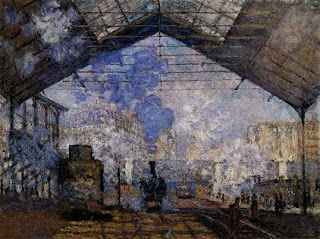During the winters of 1876 and 1877 Monet painted the train station St Lazare in Paris
Paris was going through a lot of changes at the time. Napoleon 111 had ordered a modernisation programme of Paris which was to be undertaken by Baron Haussman. Through the steam and smoke of the painting you can see some of the new buildings in the background. Impressionists often used modern settings as the inspiration for their work. Monet was particularly interested in the diffused light caused by the effect of steam on man made surfaces.
There has been little change to the view that Monet painted. You can take a train form that very station to Argentuile, where he painted his series of regatta pictures. What has changed though is the replacement of steam with diesel, and with it the loss of the atmosphere that inspired Monet.
Look at the picture and see how your eye is led in using the train tracks in the centre and the lines of perspective marked by the steel girders, roof and railway walls.The heavy buildings to the left of the picture are balanced by the people on the right. But look at the steam engine just off centre, the wheels of the train are off the track. Sometimes an artist is so carried away with capturing the essence of the scene that there can be fundamental problems with the details.
Paris was going through a lot of changes at the time. Napoleon 111 had ordered a modernisation programme of Paris which was to be undertaken by Baron Haussman. Through the steam and smoke of the painting you can see some of the new buildings in the background. Impressionists often used modern settings as the inspiration for their work. Monet was particularly interested in the diffused light caused by the effect of steam on man made surfaces.
There has been little change to the view that Monet painted. You can take a train form that very station to Argentuile, where he painted his series of regatta pictures. What has changed though is the replacement of steam with diesel, and with it the loss of the atmosphere that inspired Monet.
Look at the picture and see how your eye is led in using the train tracks in the centre and the lines of perspective marked by the steel girders, roof and railway walls.The heavy buildings to the left of the picture are balanced by the people on the right. But look at the steam engine just off centre, the wheels of the train are off the track. Sometimes an artist is so carried away with capturing the essence of the scene that there can be fundamental problems with the details.


